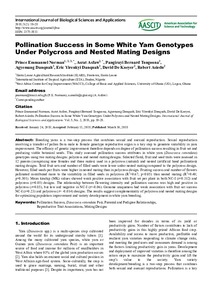| dc.contributor.author | Norman, P.E. |
| dc.contributor.author | Asfaw, A. |
| dc.contributor.author | Tongoona, P.B. |
| dc.contributor.author | Danquah, A.O. |
| dc.contributor.author | Danquah, E.Y. |
| dc.contributor.author | Koeyer, D. de |
| dc.contributor.author | Asiedu, Robert |
| dc.date.accessioned | 2019-12-04T11:18:27Z |
| dc.date.available | 2019-12-04T11:18:27Z |
| dc.date.issued | 2018 |
| dc.identifier.citation | Norman, P.E., Asfaw, A., Tongoona, P., Danquah, A., Danquah, E.Y., De Koeyer, D. & Asiedu, R. (2018). Pollination success in some white yam genotypes under polycross and nested mating designs. International Journal of Biological Sciences and Applications, 5(2), 19-28. |
| dc.identifier.issn | 2375-3811 |
| dc.identifier.uri | https://hdl.handle.net/20.500.12478/3208 |
| dc.description | Published online: 10 March 2018 |
| dc.description.abstract | Breeding yams is a two-step process that combines sexual and asexual reproduction. Sexual reproduction involving a transfer of pollen from male to female genotype reproductive organ is a key step to generate variability in yam improvement. The efficacy of genetic improvement therefore depends on degree of pollination success resulting in fruit set and producing viable botanical seeds. This study assessed pollination success attributes in white yam (Dioscorea rotundata) genotypes using two mating designs: polycross and nested mating designs. Selected floral, fruit and seed traits were assessed in 12 parents (comprising nine females and three males) used in a polycross (natural) and nested (artificial hand pollination) mating designs. Total fruit sets and number of filled seeds were lower under nested mating compared to the polycross design. However, filled seeds per fruits were higher in nested mating than in polycross design. Fruiting success and number of flowers pollinated contributed more to the variability in filled seeds in polycross (R2=0.67; p<0.05) than nested mating (R2=0.40; p=0.301). Mean kinship (MK) values showed weak positive association with fruit set per plant in both NC-I (r=0.312) and polycross (r=0.05) designs. The relationship between flowering intensity and pollination success was high and positive in polycross (r=0.85), but low and negative in NC-I (r=-0.06). Genome uniqueness had weak association with fruit set success NC-I (r=0.23) and polycross (r= -0.014) designs. The results suggest complementarity of polycross and nested mating designs for optimizing population improvement and variety development in white yam breeding. |
| dc.description.sponsorship | International Development Research Centre |
| dc.description.sponsorship | Bill & Melinda Gates Foundation |
| dc.format.extent | 19-28 |
| dc.language.iso | en |
| dc.subject | Pollination |
| dc.subject | Dioscorea Rotundata |
| dc.subject | Mating Systems |
| dc.subject | Reproduction |
| dc.subject | Yam Breeding |
| dc.subject | Genotypes |
| dc.title | Pollination success in some white yam genotypes under polycross and nested mating designs |
| dc.type | Journal Article |
| dc.description.version | Peer Review |
| cg.contributor.crp | Roots, Tubers and Bananas |
| cg.contributor.affiliation | Sierra Leone Agricultural Research Institute |
| cg.contributor.affiliation | International Institute of Tropical Agriculture |
| cg.contributor.affiliation | University of Ghana |
| cg.coverage.region | Africa |
| cg.coverage.region | West Africa |
| cg.coverage.country | Nigeria |
| cg.creator.identifier | Asrat Asfaw: 0000-0002-4859-0631 |
| cg.creator.identifier | David De Koeyer: 0000-0001-8064-6538 |
| cg.creator.identifier | Robert Asiedu: 0000-0001-8943-2376 |
| cg.researchtheme | BIOTECH & PLANT BREEDING |
| cg.identifier.url | http://www.aascit.org/journal/ijbsa |
| cg.authorship.types | CGIAR and developing country institute |
| cg.iitasubject | Genetic Improvement |
| cg.iitasubject | Plant Breeding |
| cg.iitasubject | Plant Genetic Resources |
| cg.iitasubject | Yam |
| cg.journal | International Journal of Biological Sciences and Applications |
| cg.howpublished | Formally Published |
| cg.accessibilitystatus | Limited Access |
| local.dspaceid | 94855 |
| cg.targetaudience | Scientists |

